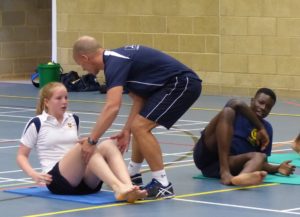Main Menu
Latest Blog Entry
User login
How to coach different learning styles
Following from Monday’s blog about coaching blind people who are visual learners. We can look in more depth at different learning styles.
The 3 learning styles
If you are to believe the coaching and teaching manuals, then you might categorise people into having 3 different learning styles:
Auditory: responds to sounds and descriptions
Visual: responds to visual images and demonstrations
Kinesthetic: learns by feeling and doing and experience.
I have yet to see the research behind this (Please contribute or reference if you can find it) despite it being quoted in lots of texts.
The more I look, the less I find that there is any evidence at all behind the so -called 3 learning styles.
It makes sense that people learn differently, and as a coach I always try to use all 3. But, as I have worked with people who are blind, deaf and have learning difficulties, I have to adapt to one style more heavily with those individuals.
One of the hardest agility sessions I had to coach was with a deaf, dyslexic person and a blind person. I had to keep switching cues and demonstrations, and body position continually.
Using Cues
Working on the agility technique recently with different athletes has highlighted the need for different cues. I have yet to find the “Magic Pill” that works on everyone. The athletic ready position was adopted by the blind players using an audio cue “pounce”.
Some of the sighted rugby players needed to practice jumping, and then see how it would aid avoiding contact in application (Kinesthetic).
Hockey and netball girls were a mixed bunch, with some getting it, others not. Time is a factor in this, but I think setting out what I want to achieve with more of a “Chalk and Talk” delivery is necessary.
I find that some high achieving girls are less likely to “have a go” in case they can’t get it straight away. I have to factor that into my coaching. (The ability to try something new and make mistakes is not always encouraged or rewarded.)
Same sweet different wrapper
One of the joys (and frustrations) of coaching is finding out how to transfer the knowledge and theory of what you want to achieve into the athlete.
It is not as simple as saying “Just do it“, instead, experimenting with a variety of cues and teaching methods will hopefully allow you to get a better working relationship with your athletes, and then better results.
Here is an example of me guiding athletes through some exercises to develop spatial awareness
If you would like to host one of our coaching courses then we will be happy to arrange.
Client Testimonials
 Blundells School
Blundells School
James has a huge breath and depth of knowledge on fitness issues. He is able to implement this knowledge into a practical course both making the task of fitness and conditioning both different and interesting from other fitness training that most are familiar with. He understands the safety issues when dealing with young adults strength and conditioning programmes. Programmes he sets are tailored to the individual needs of the group. There was a huge amount of progress made with some of these individuals in terms of their understanding of fitness and their own fitness levels.
More


